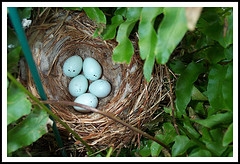The Finches Bird Nest
Several aspects must be viewed on a discussion about finches’ bird nest. First of all is the nest location. The finches bird nest is recommended to be built under a roof or portion of the aviary that is being sheltered. However, in the wild, normally the birds nest will be in the open air where the nests are always exposed to variety of temperatures, climate like rain and wind and so on.
Because of that, normally small young nestlings will not survive due to heavy rain and cold wind. Even tough the loss of some young birds in the wild nest may not impact the overall bird population, it is still a serious issue that need to be settled. This is where the finches’ bird nest comes in handy. The aviary birds will normally breed more securely in an environment where they are being protected by extreme climate changes.
The location of finches bird nest
Normally the finches bird nest will be built in a small trees or thick shrubs. Normally, the hen and the cock birds will build the finches bird nest. Normally, the cock birds and hen will build the bird nest which is made in a dome shape with some lengths of grasses, feathers, soft material, soft grasses and a side tunnel entrance. For some species, they might also build finches bird nest which can be used outside the breeding season. It is advisable not to wait until the bird has start laying its eggs on the floor. A person must start planning for breeding season in one or two months earlier depending on the purchasing of the necessary materials. Poor finches bird nest will cause the eggs to be lost and parent birds to avoid their young at the partly constructed nest.
Materials that are needed for finches bird nest
When talking about the materials that are needed to construct finches bird nest, it is always advisable to use good materials. For examples, teased natural fiber hessian that comes in short lengths can be considered. Other than that, pampas grass heads which are shorts and coconut fiber can also be counted in. Normally, birds like November grass and swamp grass which can be purchased from bird dealers normally.
One must bear in mind that the grass blades length should have varying lengths in order for the birds to choose which lengths the prefer the most. Therefore, it is better to offer different species of grasses. Normally, a strong finches bird nest can be made from dry green fresh grasses. Whereas some wild finches nest bird uses plants materials from shrubs, flowers, mosses, ferns, trees, household litter and so on. It is very important in not purchasing the materials from wild bird nest as it may has parasites, disease pathogens and mites.
Maintaining the finches bird nest
When maintaining finches bird nest, it is not recommended to replace back the young that left the nest during premature with the other new young. This is because it will interrupt the new young birds where they might also be facing the situation where they need to leave the finches bird nest in a premature stage. However, for young that left the finches bird nest at the premature stage, it is advisable to the finches bird nest owner to closely monitor whether the bird parents feed their young during the day. The immature young birds which can’t survive in climate like cold night, can be taken from the aviary, and kept in a good comfortable place before being replaced at the next morning. This in one way can help to increase the young chances of survival.






